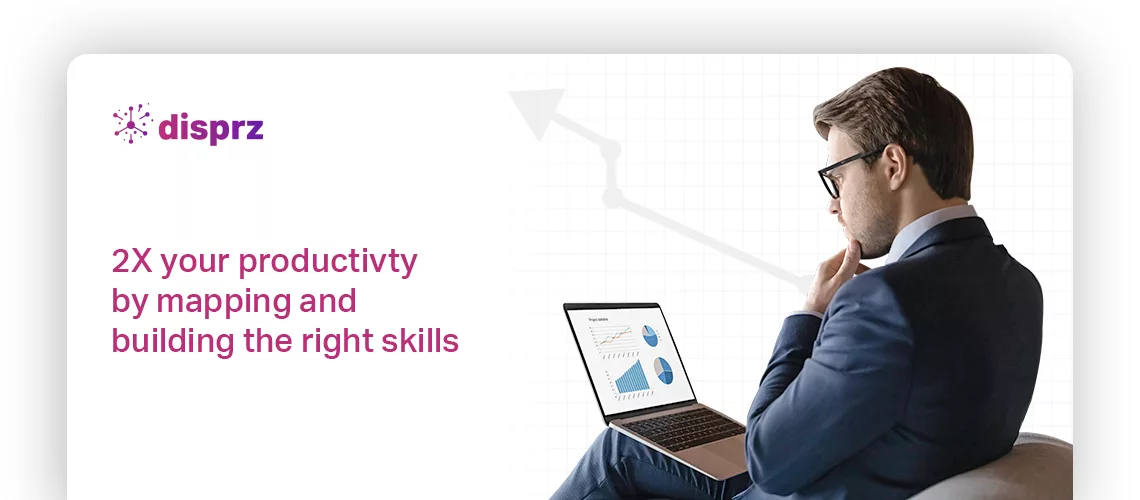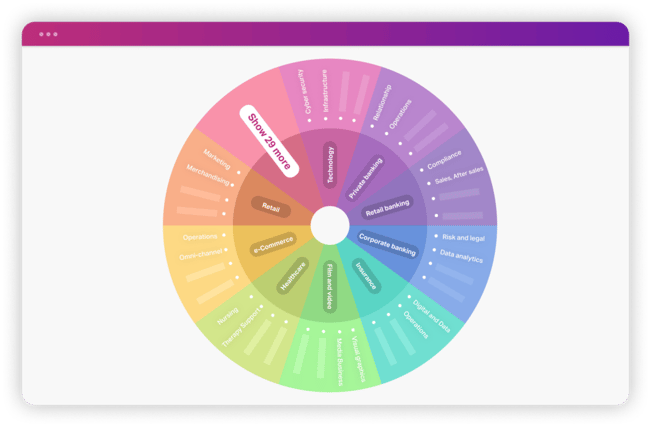
6 min read
• 13 Oct 2023
5 Benefits of Skill Mapping for Employee Development
What is skill mapping and how can it impact your employee L&D program? Discover 5 benefits of skill mapping for employee development.
-
eBookEmployee Upskilling - A Detailed Blueprint For Building A Skills-Driven Learning Culture
Skill mapping will provide valuable insights to ongoing questions about necessary skills in various roles for your company. How often have you wondered which skills are needed for your employees to meet their existing and future job requirements? Of those skills, which of them are the most important to obtain the best performance from your workforce?
How can you fill the skill gaps that employees need to be successful? Skill mapping offers an understanding of what skills an organization has, which are necessary skills, and how that is likely to change in the future. Skill mapping is ultimately used to drive desired business outcomes.
What Is Skill Mapping?
The skills mapping process identifies current and future required skills needed by employees and organizations, assessing their strengths, weaknesses, and competency to determine the talent and skills gaps that need to be filled to meet the business requirements now and as they evolve.

Each job role in an organization has many skills that employees must master to ensure high performance. In fact, Gartner notes that 58% of the workforce requires new skills to get their job done. The number of skills needed has also been increasing by 10% every year since 2017.
Skill mapping is an important part of training, learning, and development. First, you must determine what the required skills are to do each job. Then you do a skills assessment for each individual employee to identify their current skill level and identify the gaps that you will need to fill with learning and development.
Recent reports indicate that 66% of organizations are turning toward skill mapping as a way to ensure that their team has the necessary skills to move forward in uncertain times. This shows why it’s considered increasingly important to engage in mapping employee skills for companies in any industry.
5 Benefits of Skill Mapping
Now that you know what skill mapping is and why it’s important, we will share some of the top benefits of skills mapping to enhance L&D.
1. Identify Skills Gaps
When you engage in skill mapping, you utilize a repository of the skills for each job role in your organization. Assessments and/or manager reviews are normally used to identify skill gaps. Knowing where the skill level and gaps lie is important for determining what learning and development is needed to fill them.

Not only can Identifying skills gaps help build training programs but it can help create new and relevant roles to meet the needs of the team and strengthen your company. You will now be able to hire new talent with the right skills to fill the skills gaps.
2. Succession Planning
Nobody stays in an organization forever. When someone moves on, you need someone who can fill their shoes. Skill mapping lets you identify the employees who have the potential to move into leadership roles in the business.
When you identify those employees and give them the tools needed to develop, you get a robust pool of candidates to choose from, without recruitment of new talent, when you need to move forward with succession planning.
3. Increase Employee Engagement and Retention
Skill mapping has been shown to increase job satisfaction and employee engagement, which can lead to better business growth and productivity. It also shows employees a career path in the organization. This can create better employee engagement and retention. Aligning to employee goals motivates these individuals to perform at their best and participate in training programs to learn the right skills. This is a win-win for workers and the organization as a whole.
4. Talent Management
Having a skill map lets an organization make better informed decisions about which people to hire and what employees should be promoted. When you know what capabilities and skills an employee has, it can drive strategic decisions about how to utilize and develop their skill set, no matter what they are.
5. Track Progress of Specific Teams
Tracking the progress of your team is a great way to make sure things are moving forward. Skill tracking is one way to do this. You can use it to see where certain employees stand, how different teams are doing, and what to expect from one department compared to another.
Keeping track of a team’s learning curve is essential to meeting goals and can be done by using skill mapping. It’s an essential part of improving departments and being fully aware of what you can expect from individual employees.
How Leveraging an LXP Enhances Skill Mapping Initiatives for Your Organization
With skill mapping being such an essential task for organizations around the globe, you might wonder how to put it into place at your own organization. To do that, you need the right software solution. While there are many choices available, there’s nothing better than Disprz LXP.

This platform features an AI-powered upskilling solution to ensure you have skilled workers in the organization at all times. Achieve learning and upskilling with personalized solutions and a repository of information across a robust learning management platform. If you’re ready to delve into skill mapping, download the demo and get started now.
About the author

Debashree Patnaik
Debashree is a seasoned content strategist at Disprz.ai, specializing in enterprise learning and skilling. With diverse experience in B2B and B2C sectors, including ed tech, she leads the creation of our Purple papers, driving thought leadership. Her focus on generative AI, skilling, and learning reflects her commitment to innovation. With over 6 years of content management expertise, Debashree holds a degree in Aeronautical Engineering and seamlessly combines technical knowledge with compelling storytelling to inspire change and drive engagement.
More Resources
4 min read
• 15 Apr 2024
Unlocking the Power of Managerial Engagement in Talent Development
4 min read
• 09 Apr 2024
Nurturing Excellence in Building Leadership Pipelines
Sign up to get free resources and stay up to date with Disprz!
Discover how Disprz can align learning and upskilling with your desired business outcomes.





